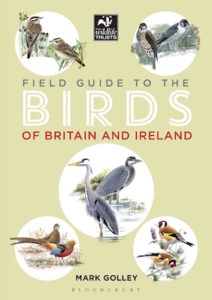As an increasingly regular – but not nearly so frequent as I would like – visitor to the British Isles, I find myself in the unusual position of having attained a familiarity with its avifauna that is marginally comfortable but all-to-easily diminished between visits. Thus whenever my feet find themselves once again on British soil and my eyes drift toward a passing bird, I am still more or less a beginning birder until all that I learned during my previous visit returns to my conscious mind.
However not long before my most recent visit (to attend the 2016 Birdfair), a copy of Mark Golley’s new Field Guide to the Birds of Britain and Ireland arrived on my desk from Bloomsbury. Written, as it is, explicitly for “both for the beginner and also the novice, as well as those with a little more birdwatching experience too” I thought it would be just the right book to take along on the nine-and-a-half hour British Airways flight between Sea-Tac and Heathrow for a quick refresher to the birdlife of the area in which I was to spend the following two weeks. Happily, I was indeed correct.
Golley’s new field guide illustrates and describes a total of just over 280 species (far fewer than the 598 found on the current British List), making it far more approachable to his designated audience. As would be expected, the species included are those most likely to be seen and reliably identified by beginning and casual birdwatchers (well, as both the Chiffchaff and Willow Warbler are included, at least “likely to be seen”).
By arranging the birds following the taxonomy in the List of Recent Holarctic Bird Species (Voous, 1977) but with some modifications from more recent works as Paleactic Birds (Beaman, 1994), Golley does a service to his beginning readers in introducing them to the order in which the birds will be found when they move on to more extensive field guides – and for those already familiar with the general taxonomy of birds, and who may simply be seeking to refresh their memories as to the species of the region, the arrangement allows more effective retention of what is presented.
David Daly’s illustrations are straight-forward, logical, and strongly focused on field observation. No species is exhaustively depicted; rather each is shown in the most commonly observed postures, i.e., divers swimming, raptors primarily in the air, plovers a mixture of in flight and on the ground. There is no splitting of hairs – or more appropriately, feathers – over lengths of third primaries and such; anything requiring minutely detailed observations is simply omitted as (rightly so) beyond the scope of the book and the interest of its likely readers.
As Golley notes, his is “a book for those with a passion for birds,” which can further be interpreted as meaning it is – and this is important – not only for those with an existing knowledge of birds. This may seem to belabor an obvious point to some, but it bears repeating: this is a book that is not only first and foremost for beginners, it is a book written unapologetically for them – something that I, after having previously reviewed far too many “beginner” books that are anything but, found both quite refreshing as well as genuinely charming. And, as the cover sports the easily recognizable and much beloved badger head crest of The Wildlife Trusts, the “UK’s largest people-powered organization caring for all nature,” you can be sure that like so many other Wildlife Trusts affiliated publications, its purpose is to allow as many people as possible to both enjoy as well as learn more about the wildlife all around them.
I think I completed my reading of the Field Guide to the Birds of Britain and Ireland somewhere over Greenland, with a second look at it somewhere over Iceland. Thus, when not long after arriving at Heathrow, a friend sent me a text message saying “We’re going to Slimbridge; I’ll collect you at your hotel shortly” I was fully prepared for what would turn out to be a most enjoyable day afield.
 Title: Field Guide to the Birds of Britain and Ireland
Title: Field Guide to the Birds of Britain and Ireland
Author: Mark Golley, with illustrations by David Daly
Publisher: Bloomsbury
Format: Paperback
Pages: 208 pp.
Published: 31 May 2016
ISBN: 9781472917461
In accordance with Federal Trade Commission 16 CFR Part 255, it is disclosed that the copy of the book read in order to produce this review was provided gratis to the reviewer by the publisher.
